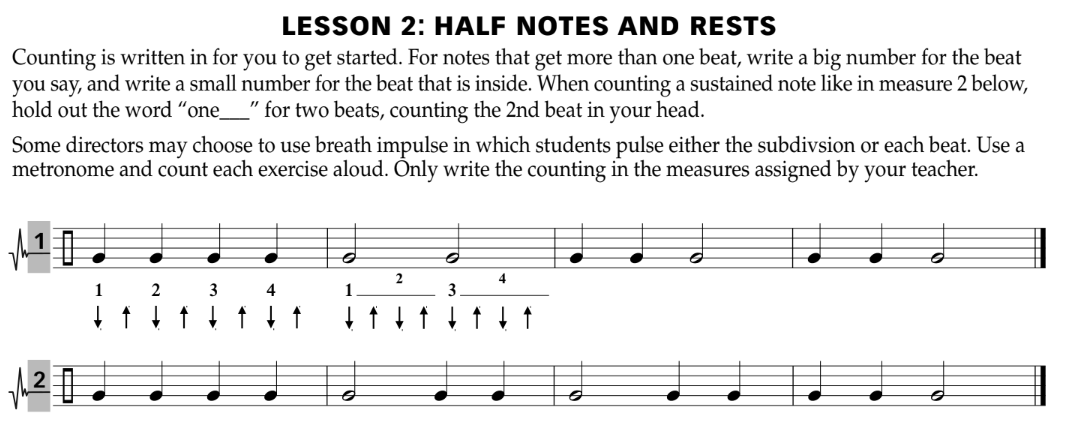
At the beginning of the year, the band hall is ripe with potential! Beginners walk through our doors with wonder and excitement, maybe some nerves—only natural in the newness. Our older students return taller, more mature (if we’re lucky), and ready to learn new music with friends. Regardless of the student, the level, or the ensemble, a smart place to approach all of our students upon the opening of a new year is with rhythm.
While songs are the goal of our students, rhythm is the foundation of musical fluency and a fundamental worthy of isolation. In fact, rhythm is the most accessible fundamental we can address with all of our students. Actual pieces of music happen because students know when to play the notes they are so excited to learn, and any time we spend on rhythm benefits their understanding and every performance forward.
Beginners
With my own beginners, I cannot imagine a better way to start their musical career than with rhythm. We start our school year with almost two weeks of rhythm (and basic note reading) taught in total isolation without an instrument. Our students come to us with varied musical knowledge, if any. Teaching rhythm requires no previous knowledge and the least amount of coordination initially. Rhythm also most closely aligns with concepts they may have approached in elementary music through clapping games, dancing, Orff instruments, Takadimi, or the like.
Because our students learn rhythm in isolation, we can teach all of our beginners together, regardless of what instrument they play. While our beginners are typically in homogeneous classes, the start of the year brings everyone within the same period together, learning and counting at the same time. Our students come from a number of feeder elementaries, and this becomes our window for creating a unified language for our band program. Everyone receives the same information at the same time, building a common foundation for everything that follows.
When rhythm is taught in isolation from the start, we ease kids into the expectations of our program in a safe environment. Their very first lessons are without the awkwardness of hand position and balancing while figuring out their embouchure simultaneously (or bow hold, etc. if referring to strings). Instead, they can focus on posture while chanting numbers they have known since they were two. They build confidence in verbalizing and articulating what our code of music means and how to write those rhythms in a way that matches the visual code. Rhythm in isolation is especially useful for our ESL students as we are only using a limited number of words in repetition, and because rhythm is based on “pictures” it is one of the easiest concepts for them to grasp in a new language.
I love that rhythm in isolation at the very beginning gives an instant structure to the start of the year. While their core classes are still ramping up, beginner classes can (and do for many of us if you use Teaching Rhythm Logically and Count Me In) start with organized, rapidly progressing rhythm lessons on the second day of school. The students see that they are learning new stuff from the start and have skills they can perform immediately. By the time they finally touch their instrument for the first time, they understand so much about music—time, note length, duration, starts and stops, timing—that their first sounds can be and are expected to be just as organized. Rhythm becomes the first layer of many skills and the foundation for all other musical concepts to follow.
 Example from Count Me In by Darcy Vogt Williams and Brian Balmages
Example from Count Me In by Darcy Vogt Williams and Brian Balmages
Performing Bands
With our older students, rhythm isn’t the first fundamental we focus on, but it is a close second. Long tones are our first priority with our performing bands, but just as we listen for open, relaxed tones we highlight clean note starts and releases. Starts and stops are an issue directly related to rhythmic awareness and accuracy, and while we approach cleaning the bookends of each note from a variety of directions, this is an easy transition back to our original fundamental: rhythm. When does a whole note end? How can we mentally subdivide the note just before the release as well as our breath beforehand?
Returning to rhythm charts is the next logical step. To begin with, it feels familiar. For our second year players suddenly in a full band environment, working rhythm charts at the start of the year closes the gap between beginner band and the performing ensemble. Our students learn confidence within this new ensemble through verbalizing, singing, and playing rhythm charts in unison where mistakes are less noticeable and the material is not new. However, because our students now come with a greater understanding, playing the rhythm charts can be a tool for addressing clean releases, balance, intonation, chords, as well as practicing style and rehearsal techniques.
Students moving into our program are given an opportunity in a safe group setting to learn and utilize our common vocabulary, which is key to assimilating into our band culture. As we work through a few lines of rhythm charts every day, we can find holes in their musical understanding before the music makes it obvious to all. It is almost never the actual note that confuses the student. It is almost always when the note happens.
Continuing on a path of consistency at all levels, rhythm is our first step in breaking new music into attainable layers even with older players. When in sectionals or a full band setting, counting new pieces or segments of new music reinforces that the rhythm is what structures pitch into song. The more we continue verbalizing and occasionally writing in the count for rhythms, the more these concepts commit to memory, allowing our students to become more self-sufficient as musicians going forward.
Rhythm is the central concept that ties all other layers of music together to create a unified work, and understanding rhythm is what creates a self-sufficient musician, unreliant on others to figure out “how it goes.” Counting is not a beginner concept; it is a fundamental concept for all musicians.